Power electronic handbook
Подождите немного. Документ загружается.

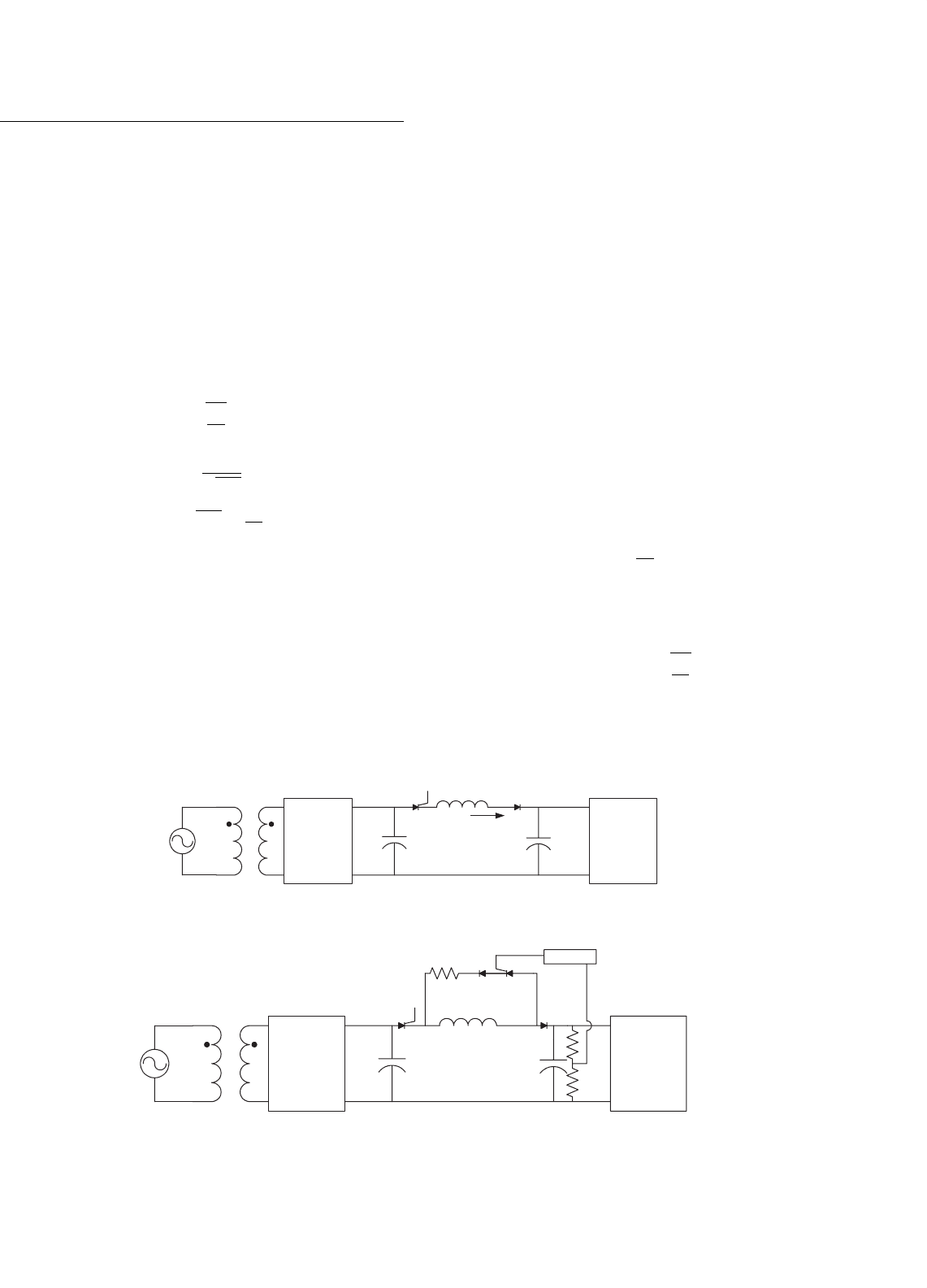
21 Power Electronics in Capacitor Charging Applications 561
21.3 Resonance Charging
The basic resonance charging technique is illustrated in
Fig. 21.4. An ac input voltage is stepped up with a transformer,
rectified, and filtered with capacitor C
2
to produce a high dc
voltage V
0
. In this circuit, C
2
is much greater than C
1
. Thyris-
tor T
1
is gated and current flows through the inductor and
diode D
1
is transferring energy from C
2
to C
1
. The voltage
v(t) and current i(t) are described by the following equations
assuming that C
2
C
1
. The charge time, t
c
, for this circuit
can be calculated by finding the time at which the current,
described by Eq. (21.2), reaches zero and is given below. The
voltage v(t) has a value of 2V
0
at the end of the charging mode.
v(t ) = V
0
(1 −cos ω
0
t) (21.1)
i(t) = V
0
C
1
L
sin ω
0
t (21.2)
ω
0
=
1
√
LC
1
(21.3)
t
c
= π
LC
1
=
π
ω
0
(21.4)
Even though this technique is simple and efficient, it is not
without its limitations. A high voltage capacitor with a large
capacitance value is needed for C
2
, which increases the cost.
A single thyristor is shown in Fig. 21.4. Multiple thyristors
connected in series or a thyratron may be required depending
on the voltage level. The repetition rate of the pulse load should
be such that C
1
is fully charged and i(t) has reached zero before
Rectifier Pulse Load
1:N
C
2
C
1
L
T
1
+
V
0
–
+
v(t)
–
i(t)
D
1
FIGURE 21.4 Resonance charging.
Rectifier Pulse Load
1:N
C
2
C
1
L
D
1
T
1
+
V
0
–
+
v(t)
–
Control
T
2
D
2
R
FIGURE 21.5 Resonance charging with de-queing.
the load discharges to prevent latch up of T
1
. It is not possible
for this circuit to operate in the refresh mode because of the
switch characteristics. Therefore, v(t) will drift due to capacitor
leakage. The charge time is a function of the circuit parameters
and will drift as they change with temperature or due to aging.
Since all of the energy stored in C
1
is transmitted from C
2
in a single pulse, it can be difficult to achieve precise voltage
regulation with the resonance charging technique. However,
regulation can be improved with the addition of a de-queing
circuit as shown in Fig. 21.5. The voltage v(t) is monitored with
a sensing network. Just before v(t) reaches the desired level,
thyristor T
2
is fired which terminates the charging mode. The
remaining energy stored in the inductor is dissipated in R. The
addition of the de-queing circuit reduces the circuit efficiency
and increases the circuit complexity and cost, but still does not
enable a refresh mode to compensate for capacitor leakage.
Boost charging, a variation on the resonance charging tech-
nique, is shown in Fig. 21.6 [1]. An extra switch is added to
the circuit of Fig. 21.4 allowing energy to be stored in both C
2
and L. This can be modeled as an increase in the voltage gain
of the CCPS. With switches S
1
and S
2
closed, the current i(t)
is given by
i(t) =
V
0
L
t (21.5)
At some time t = t
on
,S
2
is opened, and the current is now
described by
i(t) = I
0
cos ω
0
t +V
0
C
1
L
sin ω
0
t (21.6)

562 W. C. Dillard
Rectifier Pulse Load
1:N
C
2
C
1
L
D
1
+
V
0
–
+
v(t)
–
i(t)
S
1
S
2
FIGURE 21.6 Boost charging.
where
I
0
=
V
0
L
t
on
(21.7)
is the inductor current initial value at t
on
. The voltage v(t)is
then
v(t ) = I
0
L
C
1
sin ω
0
t +V
0
(
1 −cos ω
0
t
)
(21.8)
The time required for the current to reach zero and for the
voltage v(t) to reach its peak value can be calculated from
tan
(
ω
0
t
c
)
=−
I
0
L
C
1
V
0
=−ω
0
t
on
(21.9)
This is also the charge time, t
c
, or the length of the charging
mode. Note from equation (21.9) that the charge time depends
on t
on
, which is the on-time of switch S
2
. In addition, the
peak capacitor voltage is a function of t
on
. The peak capacitor
voltage is limited to 2V
0
without S
2
; voltage gains as high as
20 are possible with the addition of S
2
[1].
The switching elements in Figs. 21.4 and 21.5 are realized
with thyristors. Simple switches are shown for the boost-
charging technique in Fig. 21.6. Switch S
1
could be imple-
mented with a thyristor. The boost capability provided by
switch S
2
is best realized with a gate-controlled semiconductor
device such as a GTO or an IGBT.
21.4 Switching Converters
The poor efficiency when charging a capacitor through a resis-
tor from a high-voltage power supply limits its application to
low charging rates. In the resonance-charging concepts, the
energy is transferred to the load capacitor in a single pulse,
and it is not possible to compensate for capacitor leakage.
Energy storage capacitors may be charged utilizing the same
power electronic technology that has been applied in switch-
ing converters for constant power loads. Instead of charging
the energy storage capacitor with a single pulse, switching con-
verters can charge the capacitor with a series of pulses or pulse
train. The peak current is reduced when charging with a series
of pulses, thus improving the efficiency of the charging pro-
cess. In addition, soft-switching techniques may be employed
in the switching converter to increase the efficiency. The reg-
ulation of the output voltage is also improved with the pulse
train, because the energy is passed to the energy storage capac-
itor as small packets. Common control techniques such as
pulse-width modulation can be used to control the size of the
energy packet. This capability to control the size of the energy
packet permits the CCPS to operate in the refresh mode and
compensate for capacitor leakage. As a result, the CCPS may
operate over a broad range of load repetition rates and still
maintain tight output voltage regulation during refresh. Dur-
ing the refresh mode, energy lost due to capacitor leakage may
be replaced in a burst fashion [2] or in a continuous fashion
similar to trickle charging a battery [3].
In the switching converter, semiconductor switches may be
operated on the low side of the transformer permitting the use
of MOSFETs or IGBTs in the CCPS. Since the CCPS begins
the charging mode with a short circuit across its output, the
switching converter must be capable of operating under this
severe load condition. This may require the implementation
of a current limiting scheme in the converter control circuit.
One switching converter, topology candidate is the series
resonant converter in Fig. 21.7. Note that the MOSFETs and
resonant components L
r
and C
r
are connected on the low
voltage side of the transformer. Only the rectifier diodes and
energy storage capacitor must have high voltage ratings. When
the output rectifier is conducting, the energy storage capacitor
C
1
is connected in series with the resonant capacitor C
r
. For
a transformer turns ratio of 1:N, reflecting C
1
through the
transfomer yields a capacitance of N
2
C
1
. Since N is typically
large, this reflected capacitance is much larger than C
r
, thus
the resonant frequency, which is defined in Eq. (21.10), is not
affected by C
1
. For high voltage, high-frequency operation, the
leakage inductance of the transformer may be utilized as L
r
.
Thus, the resonant frequency can be expressed as,
ω
r
=
1
√
L
r
((NC
r
C
1
)/(C
r
+NC
1
))
(21.10)
One characteristic of this converter, which makes it attrac-
tive for capacitor charging, is the ability to operate under the
short circuit conditions present at the beginning of the charg-
ing mode. The voltage across C
1
is zero at the beginning of
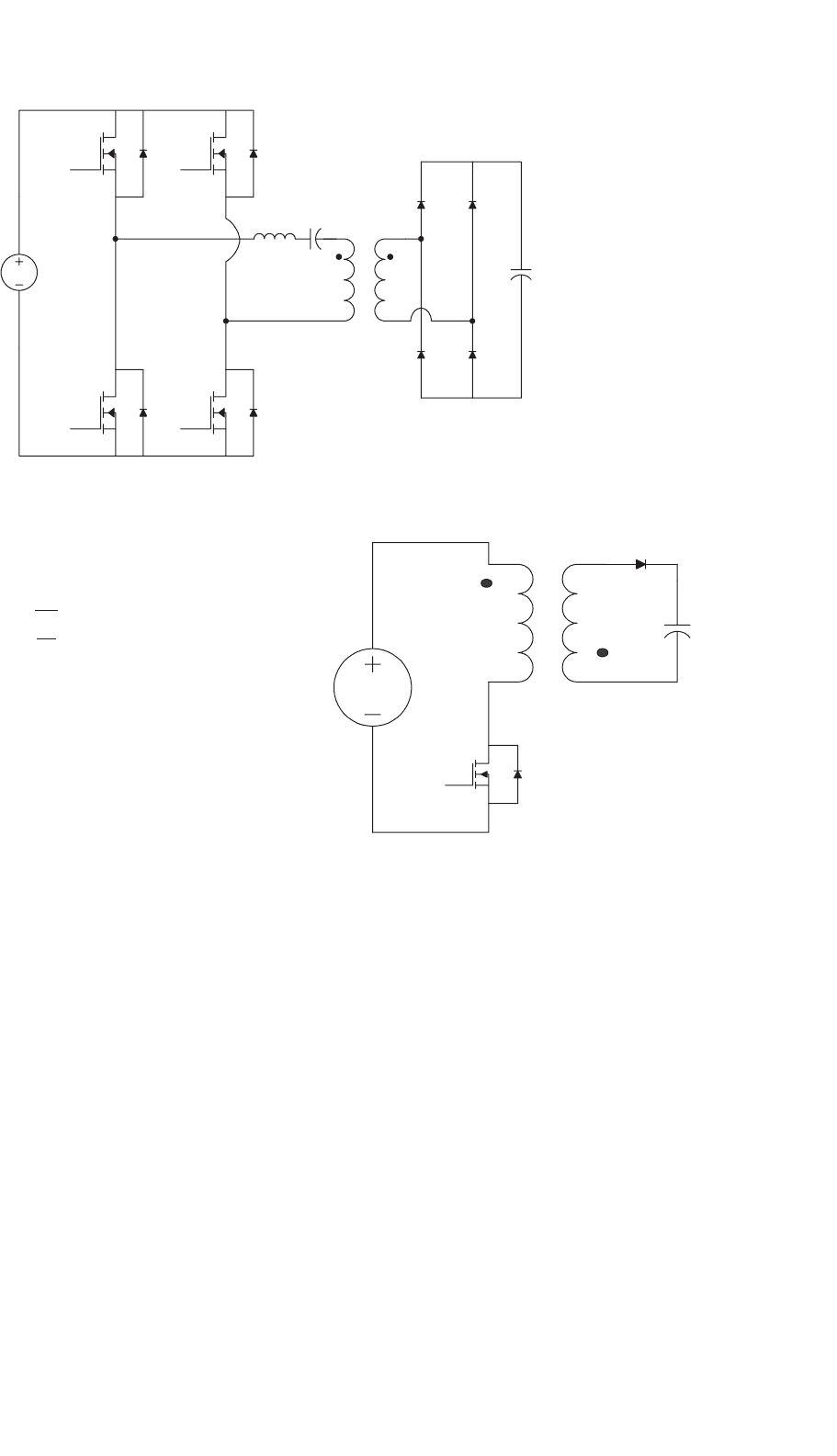
21 Power Electronics in Capacitor Charging Applications 563
L
r
V
in
T1
T2T3
T4
C
r
C
1
A
B
+
-
v
AB
1:N
FIGURE 21.7 Series resonant converter.
this mode. The current in the switches is limited by the input
voltage and impedance Z
0
as is defined in Eq. (21.11).
Z
0
=
L
r
C
r
(21.11)
Another method for current limiting is to vary the ratio of
f
s
, the switching frequency of the MOSFETs, and the resonant
frequency, f
r
, which is ω
r
/2π. This effectively controls the flow
of energy from the source to C
1
. The ratio f
s
/f
r
may be set to a
low value at the beginning of the charging mode and increased
toward one as the voltage across C
1
builds up. This limits the
current when the voltage across C
1
is low and allows increased
energy transfer as the voltage approaches the target voltage.
The disadvantage of this approach is that variable frequency
operation complicates device and component selection and
degrades EMI/EMC performance of the CCPS.
The flyback converter, shown in Fig. 21.8, also may be
utilized for capacitor charging applications [4, 5]. When the
MOSFET is turned on, current builds up in the primary wind-
ing storing energy in the magnetic field. When it reaches a
specified level, the MOSFET is turned off and energy is trans-
ferred from the magnetic field to C
1
. This energy transfer is
terminated when the MOSFET is turned on again.
In cases where precise output regulation is not required and
the packet energy is low, the diode in Fig. 21.8 can be replaced
with a Zener diode with a Zener voltage of
V
Z
= nV
in
+V
O,nom
where V
O,nom
is the nominal value of V
O
[6]. Once V
O,nom
is reached, the next energy packet will force the diode into
a brief period of breakdown with the excess energy partially
V
in
N1:N2
C
1
FIGURE 21.8 Flyback converter.
recycled to the input circuit. If the packet energy is small
enough, the breakdown is not destructive and V
O
is limited to
V
O
= V
O,nom
+V
O,
where V
O,
is the small excess voltage caused by the last
energy packet.
Sokal and Redl [7] have investigated different control
schemes for charging capacitors using the flyback converter.
Their recommendation is to charge C
1
with current pulses
which are nearly flat-topped. This strategy results in higher
average current for a given peak current. The capacitor is
charged faster because the charge delivered to it during a pulse
is directly proportional to the average current. This desired
pulse shape is achieved by turning on the MOSFET to termi-
nate the transfer of energy to C
1
soon after the MOSFET is
turned off, which increases the switching frequency. When the

564 W. C. Dillard
1:N
V
in
L
C
a
C
b
C
1
FIGURE 21.9 Ward converter.
primary current rises to a preset minimum level, the MOSFET
is again turned off. This switching strategy is essentially hys-
teretic current mode control, where the switch current is
limited between two preset bounds.
Another converter for capacitor charging applications is the
Ward converter [8–10] shown in Fig. 21.9. When the MOSFET
is on, energy is stored in the inductor and capacitor C
a
trans-
fers energy to the energy storage capacitor C
1
and capacitor C
b
.
The energy stored in the inductor is transferred to C
a
when
the MOSFET is off. The leakage inductance of the transformer
and C
a
resonate producing a sinusoidal current which flows
in the primary winding of the transformer and the MOSFET.
When the primary current reaches zero and starts negative,
the diode turns on which allows the MOSFET to be turned off
efficiently at zero current.
In some converter operating conditions, the voltage across
C
a
is very small because most of the energy has been trans-
ferred from C
a
to C
1
. The energy stored in C
a
may be too
small to ensure zero-current turn off of the MOSFET. In this
case, the energy stored in C
b
helps to ensure that the ampli-
tude of the current is large enough for zero-current turn off of
this device.
References
1. P. K. Bhadani, “Capacitor-Charging Power Supply for Laser Pulsers
Using a Boost Circuit,” Review of Scientific Instruments, Vol. 60,
No. 4, April 1989, pp. 605–607.
2. A. C. Lippincott and R. M. Nelms, “A Capacitor-Charging
Power Supply Using a Series-Resonant Topology, Constant
On-Time/Variable Frequency Control, and Zero Current Switching,”
IEEE Transactions on Industrial Electronics, Vol. 38, No. 6,
December 1991, pp. 438–447.
3. B. E. Strickland, M. Garbi, F. Cathell, S. Eckhouse, and M. Nelms,
“2 kJ/sec 25-kV High-Frequency Capacitor-Charging Power Sup-
ply Using MOSFET Switches,” Proceedings of the 1990 Nineteenth
Power Modulator Symposium, June 1990.
4. R. L. Newsom, W. C. Dillard, and R. M. Nelms, “Digital Power-
Factor Correction for a Capacitor-Charging Power Supply,” IEEE
Transaction on Industrial Electronics, Vol. 49, No. 5, October 2002,
pp. 1146–1153.
5. F. P. Dawson and S. B. Dewan, “A Subresonant Flyback Converter
for Capacitor Charging,” Proceedings of the Second Annual IEEE
Applied Power Electronics Conference, March 1987, pp. 274–283.
6. W. C. Dillard and R. M Nelms, “A Digitally-Controlled, Low-
Cost Driver for Piezoceramic Flight Control Surfaces in Small
Unmanned Aircraft and Munitions,” Seventeenth Annual Applied
Power Electronics Conference and Exposition, 2002, APEC ’02,
pp. 1154–1160.
7. N. O. Sokal and R. Redl, “Control Algorithms and Circuit Designs for
Optimally Flyback-Charging an Energy-Storage Capacitor (e.g. for
flash lamp or defibrillator),” IEEE Transactions on Power Electronics,
Vol. 12, No. 5, September 1997, pp. 885–894.
8. M. A. V. Ward, “DC to DC Converter Current Pump,” U.S. Patent
Number 4,868,730, September 1989.
9. G. C. Chryssis, “High-Frequency Switching Power Supplies: Theory
and Design,” McGraw-Hill Publishing, New York, 1989.
10. R. M. Nelms and J. E. Schatz, “A Capacitor Charging Power Sup-
ply Utilizing a Ward Converter,” IEEE Transactions on Industrial
Electronics, Vol. 39, No. 5, October 1992, pp. 421–428.

22
Electronic Ballasts
J. Marcos Alonso, Ph.D.
University of Oviedo, DIEECS -
Tecnologia Electronica, Campus
de Viesques s/n, Edificio de
Electronica, 33204 Gijon,
Asturias, Spain
22.1 Introduction .......................................................................................... 565
22.1.1 Basic Notions • 22.1.2 Discharge Lamps • 22.1.3 Electromagnetic Ballasts
22.2 High Frequency Supply of Discharge Lamps ................................................ 571
22.2.1 General Block Diagram of Electronic Ballasts • 22.2.2 Classification of Electronic
Ballast Topologies
22.3 Discharge Lamp Modeling........................................................................ 575
22.4 Resonant Inverters for Electronic Ballasts .................................................... 578
22.4.1 Current-fed Resonant Inverters • 22.4.2 Voltage-fed Resonant Inverters
• 22.4.3 Design Issues
22.5 High Power Factor Electronic Ballasts......................................................... 586
22.5.1 Harmonic Limiting Standards • 22.5.2 Passive Solutions • 22.5.3 Active Solutions
22.6 Applications........................................................................................... 589
22.6.1 Portable Lighting • 22.6.2 Emergency Lighting • 22.6.3 Automotive Lighting
• 22.6.4 Home and Industrial Lighting • 22.6.5 Microprocessor-based Lighting
Further Reading ..................................................................................... 590
22.1 Introduction
Electronic ballasts, also called solid-state ballasts, are those
power electronic converters used to supply discharge lamps.
The modern age of electronic ballasts began with the intro-
duction of power bipolar transistors with low storage time,
allowing to supply fluorescent lamps at frequencies of several
kilohertz and increasing lamp luminous efficacy by operating
at these high frequencies. Later, electronic ballasts became very
popular with the development of low cost power MOSFETs,
whose unique features make them very attractive to implement
solid-state ballasts. The main benefits of electronic ballasts are
the increase in the lamp and ballast overall efficiency, increase
in lamp life, reduction of ballast size and weight, and improve-
ment in lighting quality. This chapter attempts to give a general
overview about the more important topics related to this type
of power converters.
22.1.1 Basic Notions
Discharge lamps generate electromagnetic radiation by means
of an electric current passing through a gas or metal vapor.
This radiation is discrete, as opposed to the continuous
radiation emitted by an incandescent filament. Figure 22.1
shows the electromagnetic spectrum of an electric discharge,
which consists of a number of separate spectral lines.
As can be seen in Fig. 22.1, only the electromagnetic radi-
ation emitted within the visible region (380–780 nm) of the
radiant energy spectrum is useful to provide lighting. The total
power in watts emitted by an electric discharge can be obtained
by integrating the spectral energy distribution. However, this
is not a suitable parameter to measure the amount of light
emitted by a discharge lamp.
The human eye presents different responses to the differ-
ent types of electromagnetic waves within the visible range. As
illustrated in Fig. 22.2, there exist two response curves. First,
the photopic curve, also called V (λ), is the characteristic used
to represent the human eye behavior under normal illuminat-
ing level conditions or daylight vision. Second, the scotopic
curve V
(λ) is the response of the human eye for situations
with low illuminating levels, also known as nocturnal vision.
The reason for this different behavior is physiologic. The
human eye consists of two types of photoreceptors: rods and
cones. Rods are much more sensitive at low lighting levels than
cones, but they are not sensitive to the different light colors.
On the other hand, cones are responsible for normal color
Copyright © 2007, 2001, Elsevier Inc.
All rights reserved.
565
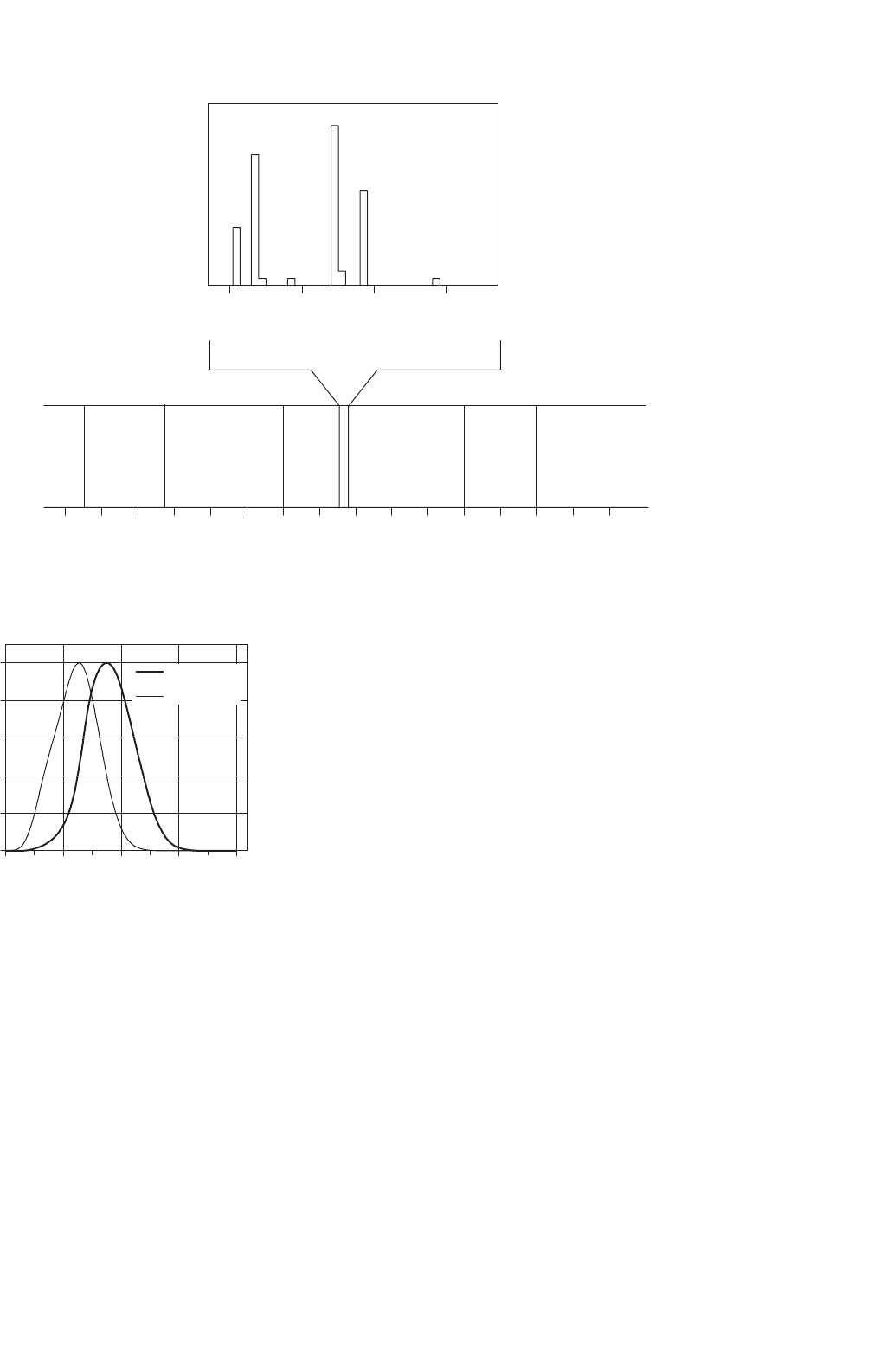
566 J. M. Alonso
400 500 600 700
λ (nm)
P (λ)
VISIBLE LIGHT: 380–780 nm
10
−12
10
−6
10
−4
10
−2
110
−8
10
−10
UV IR
λ (nm)
Microwave TV & RadioX-Rays
10
−14
Gamma
Rays
Cosmic
Rays
FIGURE 22.1 Spectral energy distribution of an arc discharge and radiant energy spectrum.
0
0.2
0.4
0.6
0.8
1
380 480 580 680 780
Photopic
Scotopic
λ (nm)
FIGURE 22.2 Spectral luminous efficiency functions for standard pho-
topic and scotopic observers.
vision at higher lighting levels. Normally, only the photopic
function is considered in lighting design and used to calibrate
photometers.
Since, the human eye responds in different ways to the dif-
ferent wavelengths or colors, the output power of a lamp,
measured in watts, is no longer applicable to represent the
amount of light generated. Thus, a new unit is used to incor-
porate the human eye response, which is called lumen. The
total light output of a lamp is then measured in lumens and
it is known as lamp luminous flux. The lamp luminous flux is
obtained by integrating the radiant power as follows:
= K
m
780nm
380nm
P(λ)V (λ)dλ (22.1)
where K
m
represents the maximal spectral luminous effi-
cacy, which is equal to 683 lumens/watt (at λ = 555 nm)
for photopic vision and 1700 lumens/watt (at λ = 507 nm)
for scotopic vision. The standard photopic and scotopic
functions were defined by the International Commission on
Illumination (CIE) in 1924 and 1951, respectively.
The measurement of the lamp total luminous flux results is
very useful to know whether or not the lamp is working prop-
erly. At the laboratory, the measurement of the lamp total
luminous flux is performed by means of an integrating sphere
and using the substitution method. The integrating sphere,
also known as Ulbricht photometer, is internally coated with
a perfectly diffusing material. Thus, the sphere performs the
integral in Eq. (22.1) and the illuminance on the internal sur-
face is proportional to the total luminous flux. A photometer
with a V (λ) filter is placed so that the internal illuminance can
be measured, and a baffle is placed to avoid direct illumina-
tion of the photometer probe by the lamp. The measurement
is made in two steps, one with the lamp under test in place and
the other with a standard lamp of known total luminous flux.
From the two measurements, the total luminous flux of the
lamp under test is deduced by linear relationship. Figure 22.3
illustrates an integrating sphere photometer.
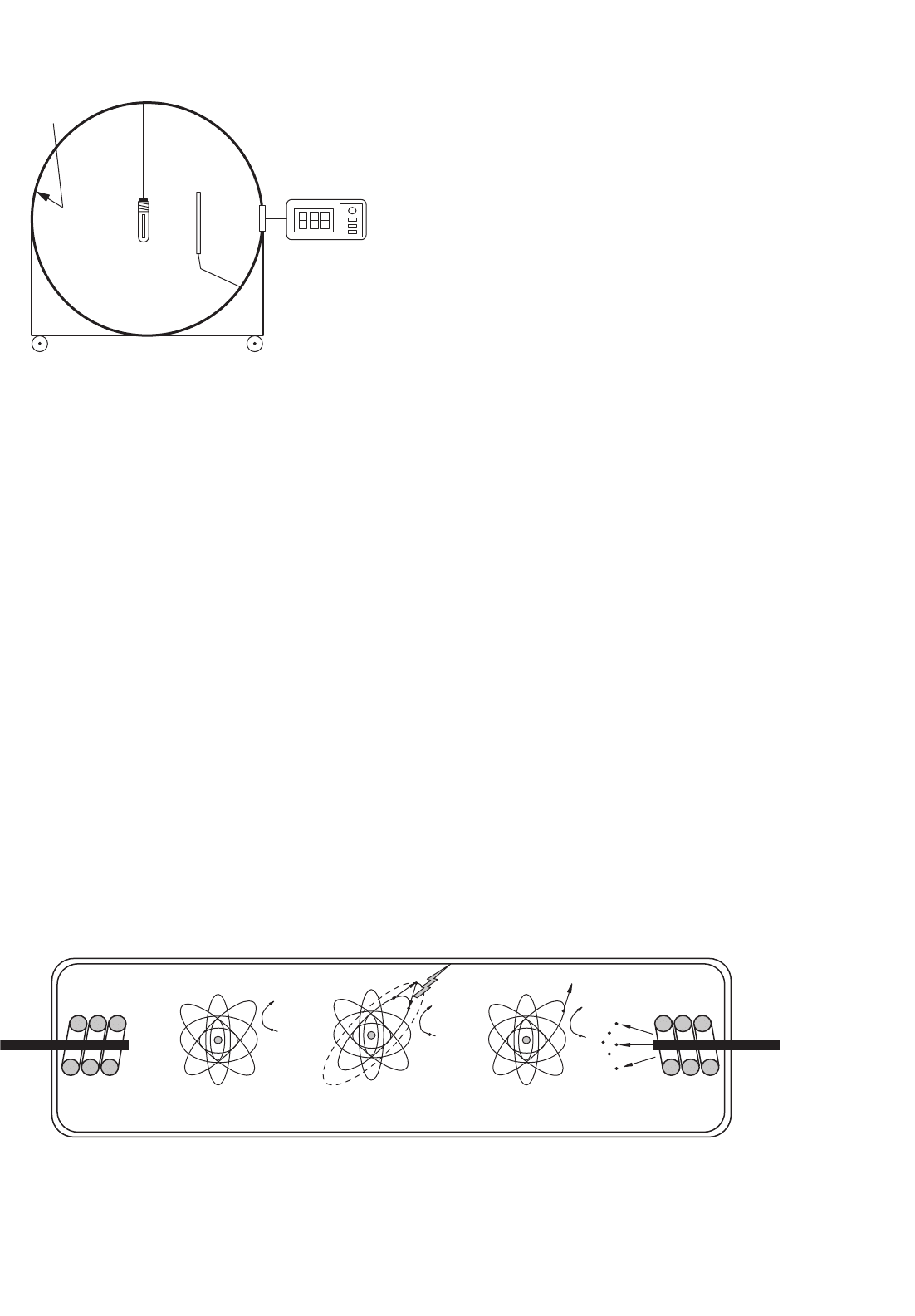
22 Electronic Ballasts 567
Lamp
Baffle
Photometer with
V(λ) probe
Perfectly Diffusing
Coating
FIGURE 22.3 Integrating sphere used for measurement of the lamp
total luminous flux.
An important parameter related to the supply of discharge
lamps is the luminous efficacy. Luminous efficacy is defined as
the rate of the lamp total luminous flux to the total electric
power consumed by the lamp, usually expressed in lumens
per watt. The luminous efficacy of a discharge lamp can be
increased by proper designing of the electronic ballast, which
finally results in energy saving.
22.1.2 Discharge Lamps
Basically, discharge lamps consists of a discharge tube inside
which the electric energy is transformed into electromagnetic
radiation. The discharge tube is made of a transparent or
translucent material with two sealed-in electrodes placed at
both ends, as shown in Fig. 22.4. The discharge tube is filled
with an inert gas and a metal vapor. The electrodes gener-
ate free electrons, which are accelerated by the electrical field
existing in the discharge. These accelerated electrons collide
with the gas atoms, having both elastic and inelastic collisions
depending on the electron kinetic energy. The basic processes
inside the discharge tube are illustrated in Fig. 22.4. They are
as follows:
1. Heat generation. When the kinetic energy of the electron
is low, an elastic collision takes place and only a small part of
Heat generation Energy radiation Ionization
Electrode
Electrons
FIGURE 22.4 Basic processes inside the discharge tube.
the electron energy is transferred to the gas atom. The result
of this type of collisions is an increase in the gas tempera-
ture. In this case, the electrical energy is consumed to produce
heat dissipation. However, this is also an important process
because the discharge has to set in its optimum operating
temperature.
2. Gas atom excitation. Some electrons can have a high
kinetic energy so that the energy transferred in the collision
is used to send an electron of the gas atom to a higher orbit.
This situation is unstable and the electron tends to recover its
original level, then emitting the absorbed energy in the form
of electromagnetic radiation. This radiation is used to directly
generate visible light or, in other case, ultraviolet radiation is
first generated and then transformed into visible radiation by
means of a phosphor coating existing in the inside wall of the
discharge tube.
3. Gas atom ionization. In some cases, electrons have gained
such high kinetic energy that during the collision with the gas
atom, an electron belonging to the gas atom is freed, resulting
in a positive charged ion and a free electron. This freed electron
can play the same roles as those generated by the electrodes.
This process is specially important during both discharge igni-
tion and normal running, because ionized atoms and electrons
are necessary to maintain the electrical current through the
lamp.
The number of free electrons in the discharge can increase
rapidly due to continuing ionization, producing an unlim-
ited current and finally a short-circuit. This is illustrated in
Fig. 22.5, which shows how the voltage–current characteristics
of a gas discharge exhibits a negative differential resistance.
Therefore, in order to limit the discharge current, the use of
an auxiliary supply circuit is mandatory. This circuit is called
ballast.
Focusing on discharge lamps, the complete stabilization
process consists of two main phases:
1. Breakdown phase. Most of the gases are very good insu-
lators and an electric discharge is only possible if a sufficient
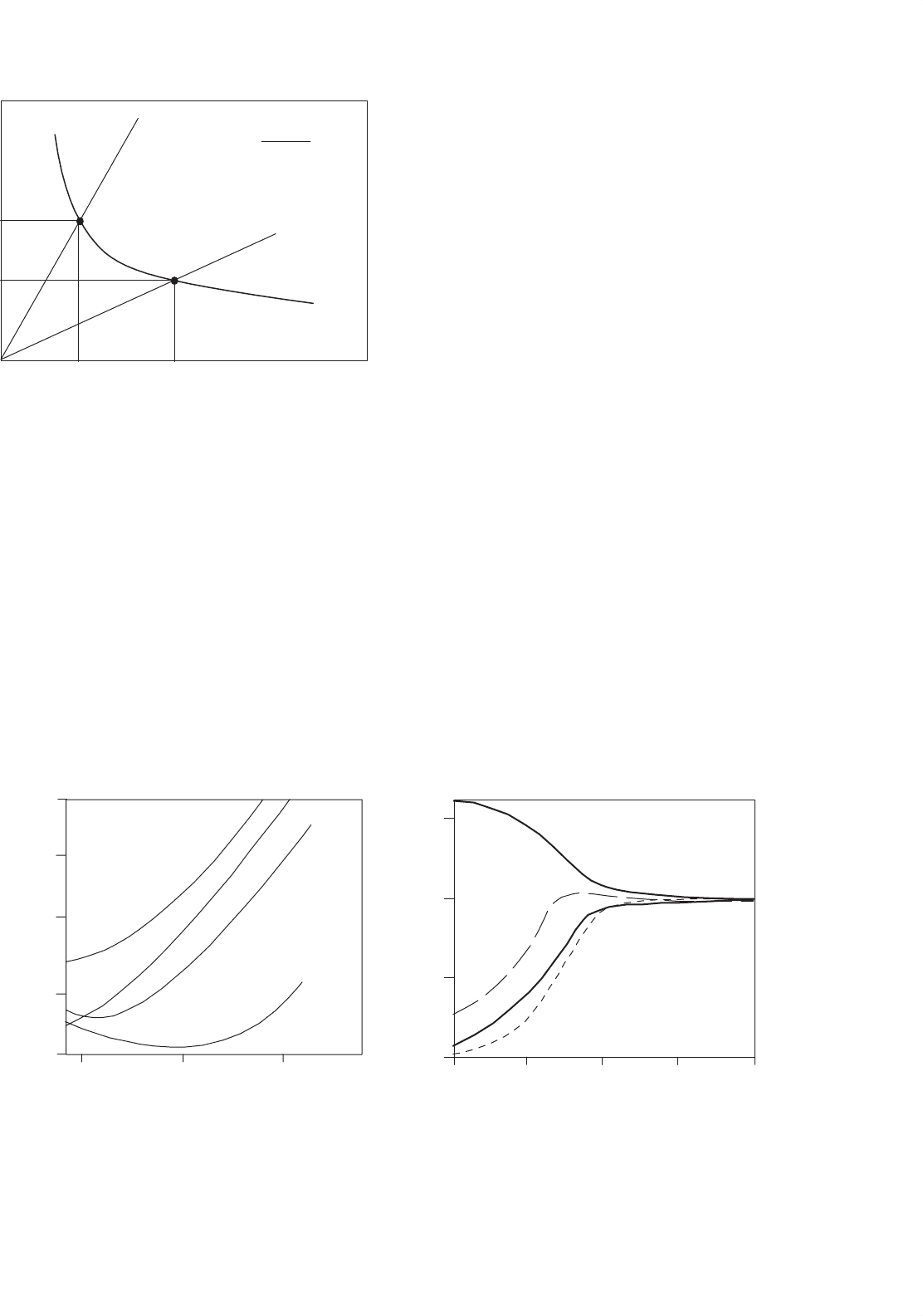
568 J. M. Alonso
V
I
V
1
V
2
I
1
I
2
P
1
P
2
R
1
R
2
R
d
=
I
2
− I
1
V
2
− V
1
< 0
FIGURE 22.5 Voltage–current characteristics of a gas discharge.
concentration of charged particles is present. Normally, a high
voltage is used to provide electricity carriers and to initi-
ate the discharge. The minimum voltage applied to initiate
the discharge is called starting voltage. The starting voltage
mainly depends on the type of gas, gas pressure, and distance
between electrodes. Figure 22.6a represents the starting volt-
age as a function of the product gas pressure by electrode
distance, for different gases. These functions are known as
Paschen curves.
Usually, auxiliary inert gases are used to decrease the starting
voltage. Particularly, there exist some special inert gas mix-
tures, presenting a very low starting voltage, which are called
Penning mixtures. These penning mixtures are very often used
1 10 100
100
200
500
1000
2000
V
o
(V)
Xe
Ar
Ne
Ne + 0.1% Ar
p·l
e
(Pa·m)
0 1.0 2.0 3.0 4.0
0
50
100
150
%
Time (minutes)
I
P
V
Φ
I - Current
V- Voltage
P- Power
Φ- Total Luminous Flux
(a) (b)
FIGURE 22.6 (a) Paschen curves for different inert gases and (b) stabilization curve of a discharge lamp.
as initial starting gas. Figure 22.6a shows a typical penning
mixture constituted by neon with 0.1% of argon.
2. Warm-up phase. Once the lamp is ignited, the collisions
between free electrons and atoms generate heat and discharge
temperature increases until reaching the normal operation
conditions. During this phase, the heat is used to evaporate
the metal atoms existing in the discharge tube and the emit-
ted electromagnetic radiation assumes the character of a metal
vapor discharge instead of an inert gas discharge. From the
electrical point of view, the discharge warm-up phase shows
initially low discharge voltage and high discharge current. As
long as more and more metal atoms are evaporated, the dis-
charge voltage increases and the discharge current decreases.
Finally, an equilibrium is reached at steady-state operation
with the normal values of voltage and current. The time con-
stant of the warm-up phase strongly depends on the lamp
type. It varies from seconds for fluorescent lamps to minutes
for high-intensity discharge lamps.
Figure 22.6b illustrates some discharge waveforms during
the warm-up phase.
The basic elements used in lamps to generate radiation in
the visible part of the spectrum are sodium and mercury. The
former generates radiation directly within the visible part of
the spectrum; the latter generates radiation mainly in the ultra-
violet region, but this radiation can be easily transformed in
visible radiation by means of a phosphor coating on the inter-
nal wall of the discharge tube. Besides the element used, a very
important parameter related to the efficiency and richness of
the emitted radiation is the discharge pressure. For the sodium
and mercury elements, there exist two pressure values around

22 Electronic Ballasts 569
which the luminous efficacy of the discharge is higher. The first
is obtained at quite low-pressures, about 1 Pa, and the second
at higher pressures, around 10
5
Pa (1 at). This is the reason
why there exist two main types of discharge lamps:
1. Low-pressure discharge lamps. This type of lamps oper-
ates with pressures around 1 Pa and they feature low current
density inside the discharge and low power per unit of dis-
charge length. Therefore, these lamps present normally a quite
large discharge volume with low power rating. Most represen-
tative examples are low-pressure mercury lamps, also known
as fluorescent lamps and low-pressure sodium lamps.
2. High-pressure discharge lamps. The operating pressure
in this type of lamps is around 10
5
Pa and higher, in order
to achieve a considerable increase in the luminous efficacy
of the discharge. These lamps present a high-current density
in the discharge and a high power per discharge length ratio,
thus showing much smaller discharge tubes. Examples of these
lamps are high-pressure sodium lamps, high-pressure mercury
lamps, and metal halide lamps.
Finally, to characterize the light produced by a discharge
lamp, it is necessary to know two important concepts: the
correlated color temperature (CCT) and the color rendering
index (CRI).
The CCT is defined as the temperature of the blackbody
radiator whose perceived color most closely resembles that of
the discharge lamp. The color of an incandescent body changes
as its temperature rises from deep red to orange, yellow, and
finally white. Thus, a cool white fluorescent lamp has a CCT
around 3500 K and it is perceived as a white source of light,
whereas a high pressure-sodium lamp presents a CCT of about
2000 K and it appears as yellow.
The CRI of a light source is the effect that the source has on
the color appearance of the objects under it, when compared
to their appearance under a reference source of equal CCT.
The measurement gives a value lower than 100, and the higher
the CRI, the better the color rendition. For example, daylight
and incandescent lamps has a CRI equal to 100.
To conclude this introduction on the discharge lamps, some
comments regarding the most important types of discharge
TABLE 22.1 Comparison of different discharge lamps
Lamp Wattage (W) Luminous efficacy (lm·W
−1
) Life (h) CCT (K) CRI
Fluorescent 4–100 62 20,000 4200 62
Compact fluorescent 7–30 60–80 10,000 2700–5000 82
Low-pressure sodium 50–150 110–180 15,000 1800 <0
Mercury vapor 50–1000 40–70 24,000 4000–6000 15–50
Metal-halide 40–15,000 80–125 10,000 4000 65
HPS 35–1000 65–140 24,000 2000 22
HPS(Amalgam) 35–1000 45–85 10,000 2200 65
lamps will be given. Table 22.1 provides some additional data
on the different discharge lamps for comparison.
1. Fluorescent lamps. These lamps belong to the category of
low-pressure mercury vapor discharge lamps. The discharge
generates two main lines at 185 and 253.7 nm and other weak
lines in the visible range of the spectrum. A fluorescent powder
on the inside wall of the discharge tube converts the ultraviolet
radiation into visible radiation, resulting in a broadband spec-
tral distribution and good color rendition. In these lamps, the
optimum mercury vapor pressure (which gives the maximum
luminous efficacy) is 0.8 Pa. For the tube diameters normally
used, this pressure is reached at a wall temperature of about
40
◦
C, not much higher than typical ambient temperature. The
heat generated inside the discharge is sufficient to attain the
required operating temperature without using an outer bulb.
However, this structure causes a great variation of the lamp
lumen output with the temperature, which is one important
drawback of the fluorescent lamps. One solution to this prob-
lem is the addition of amalgams to stabilize the light output.
This is specially used in compact fluorescent lamps.
2. Low-pressure sodium lamps. These lamps are the most
efficient source of light. The reason is the almost monochro-
matic radiation that they generate, with two main lines at 589
and 589.6 nm, very close to the maximum human eye sensi-
tivity. Therefore, color rendition of these lamps is very poor,
however contrasts are seen more clearly under this light. This
is the reason for using these lamps in situations where the
recognition of objects and contours is essential for safety, such
as motorway bridges, tunnels, intersections, and so on. The
optimum pressure for the low-pressure sodium discharge is
about 0.4 Pa, attained in normal discharge tubes at a temper-
ature of 260
◦
C. An outer bulb is normally used to reach and
maintain this temperature.
3. High-pressure mercury vapor lamps. The increase in the
pressure of the mercury vapor produces a radiation richer
in spectral lines, some of them are in the visible part of
the spectrum (405, 436, 546, and 577/579 nm). This leads

570 J. M. Alonso
to an increase in the luminous efficacy, reaching values of
40–60 lm·W
−1
at pressures 10
5
–10
7
Pa (1–100 at). These
lamps operate with unsaturated mercury vapor, which means
that all the mercury in the discharge tube has evaporated
and the number of mercury atoms per unit volume remains
constant. Thus, the operation of this type of lamps is more
independent of the temperature than most other discharge
lamps. One drawback of these lamps is the lack of spectral lines
in the long wavelengths (reds) of the spectrum, thus showing
low CRI. An increase of the color rendition can be obtained
by adding metal-halide compounds into the discharge tube, in
order to generate radiation all over the visible spectrum. These
lamps are known as metal-halide lamps.
4. High-pressure sodium lamps. This is a very popular
source of light due to its high luminous efficacy and long
life. The increase in the sodium vapor pressure produces a
very widening spectrum, with good color rendition compared
to the low-pressure sodium lamps. This also leads to a lower
luminous efficacy but it is still higher than the other high
intensity discharge lamps. Some of these lamps also incorpo-
rate mercury in the form of sodium amalgam to increase the
field strength of the discharge, thus decreasing the discharge
current. A lower lamp current and a higher lamp voltage
allows to reduce the size and cost of the ballast. However,
the addition of sodium amalgam strongly reduces the life of
the lamp.
22.1.3 Electromagnetic Ballasts
Electromagnetic ballasts are commonly used to stabilize the
lamp at the required operating point by limiting the discharge
current. The operating point of the lamp is given by the inter-
section of both lamp and ballast characteristics, as shown in
Fig. 22.7. The ballast line is the characteristic which shows
the variation of the lamp power vs lamp voltage for a con-
stant line voltage, and can be measured during the warm-up
phase of the lamp. The lamp line is the characteristic which
gives the variation of the lamp power as a function of the
lamp voltage for different line voltages, and can be measured
by varying the line voltage. Some lamps, like high-pressure
sodium, exhibit a great variation of lamp voltage with changes
in the lamp wattage. Because of this behavior, trapezoids have
been established which define maximum and minimum per-
missible lamp wattage vs lamp voltage for purposes of ballast
design, as shown in Fig. 22.7.
Figure 22.8 shows basic electromagnetic ballast used to
supply low- and high-pressure lamps at line frequencies
(50–60 Hz). Figure 22.8a illustrates the typical circuit used
to supply fluorescent lamps with preheating electrodes, which
basically uses a series inductor to limit the current through
the discharge. Initially the glow switch is closed and the short-
circuit current flows through the circuit, heating the electrodes.
LAMP
WATTAGE
LAMP VOLTAGE
Maximum lamp wattage
Minimum lamp wattage
Lamp line
Ballast line
Maximum Lamp
Voltage
Minimum Lamp
Voltage
Operating
Point
FIGURE 22.7 Lamp and ballast characteristics.
A fraction of a second later, the glow switch is opened and the
energy stored in the ballast inductor causes a voltage spike
between the lamp electrodes (about 800 V), which finally pro-
duces the discharge breakdown. Once ignited, the lamp voltage
is lower than the line voltage and the glow switch remains
open during the normal lamp operation. Typical glow switches
are based on two bi-metal strips inside a small tube filled
with an inert gas. An external capacitor of about 10 nF is
used to enhance the glow-switch operation and also to reduce
radio interference during lamp starting. Finally, in this type
of inductive ballasts a capacitor placed across the line input is
mandatory to achieve a reasonable value of the input power
factor.
Starting voltages of high-pressure discharge lamps are nor-
mally higher than low-pressure discharge lamps and can range
from 2500 V for a lamp at room temperature to 30–40 kV to
re-ignite a hot lamp. Thus, the simple ignition system based
on the glow switch is no longer applicable for these lamps.
Figures 22.8b and c show two typical arrangements to supply
high-intensity discharge lamps. A series inductor is also used
to limit the lamp current at steady-state operation but auto-
transformers are used to attain higher voltage spikes for lamp
ignition. For higher line voltages and short distances between
starter and lamp, the inductor ballast can be used as ignition
transformer as shown in Fig. 22.8b. In other cases, a separate
igniting transformer is needed to provide higher voltage spikes
and to avoid the effect of parasitic capacitance of connection
cables (Fig. 22.8c).
The inductive ballast provides low lamp-power regula-
tion against line voltage variation and therefore it is only
recommended in those installations with low voltage fluc-
tuations. When a good lamp power regulation is necessary
the circuit shown in Fig. 22.8d is normally used. This cir-
cuit is commonly named as constant wattage autotransformer
(CWA) and incorporates a capacitor in series with the lamp
to limit the discharge current. Compared with the normal
